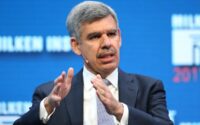A drop in credit card spending is raising concerns about the financial health of the US consumer and the outlook for holiday sales as cardholders face record-high interest charges.
The fall in card spending comes as consumers’ finances are being strained by both higher interest rates and debt loads, particularly when it comes to borrowing on credit cards. This debt has been rising in the past year and recently topped $1tn for all Americans for the first time.
“Credit card spending was soft in September, and what was notable was that softness was across all sectors,” said Citigroup economist Robert Sockin.
Credit cards, unlike mortgages and other types of consumer credit, tend to have variable terms, and are among the first types of debt on which consumers feel the impact of rising rates.
On Friday, the Federal Reserve reported that the average annual interest rate that consumers are paying on credit card balances hit a record high of 22.8 per cent at the end of August, up from 16.3 per cent a year ago.

As a result, US consumers are in line to pay as much as $40bn more on interest payments in the next year on their credit card balances than they were a year ago, according to WalletHub, which tracks credit cards and consumer finances.
“We have heard that there is a slowdown in the credit card market,” said WalletHub’s chief executive Odysseas Papadimitriou. “The people who are carrying credit card debt are carrying it for longer, and not paying it down as much.”
Credit card spending at retailers dropped nearly 11 per cent last month, Citi reported this week, based on data from the bank’s own card customers. That decline, the fifth consecutive month of “spending deceleration”, was the largest of the year so far.
“After a solid summer, spending appears to have decelerated post-Labor Day,” Bank of America economist Shruti Mishra wrote in a research note on Thursday.
Citigroup chief executive Jane Fraser last week warned that “cracks” were emerging in the health of US consumers. “I think some of the excess savings from the Covid years are getting close to depletion,” Fraser said, speaking on CNBC.
Top retail executives have also warned that rising interest rates could dampen consumer spending for the rest of the year. Walmart chief executive Doug McMillon said in August that rising gas, utilities and borrowing costs would take their toll on consumers.
“Household budgets are still under pressure,” McMillon said.
While there has been a marked slowdown in credit card spending, default rates, while up, are not much higher than they were before the start of the pandemic. And US consumers appear, at least for the moment, to be supported by a strong jobs market. The US labour department reported on Friday that employers collectively increased their payrolls by a stronger than expected 336,000 positions in September.
“The continued strength in the labour market, including solid gains in employment and real wages, has supported spending against forecasts for a looming downturn in activity,” noted Michael Hanson at JPMorgan.
“While the health of the consumer will ultimately turn on the health of the labour market, household balance sheets remain robust.”
Consumers have been spending down savings accumulated during the Covid lockdowns when interest rate payments were put on hold, and the government dolled out direct payments and other stimulus measures to combat the economic impact of lockdowns.
But since March 2022, the Fed has rapidly raised rates to battle persistent inflation. The policy rate now hovers at a 22-year high of 5.25-5.5 per cent. Officials are still toying with the idea of delivering one more quarter-point rate rise this year before pausing for most of 2024.
Overall consumer spending, which includes rent and other purchases that consumers do not typically put on credit cards, is continuing to increase, though at a slower pace. Some economists say the drop in spending on credit cards reflects growing financial strains on lower income consumers, who rely more heavily on revolving credit, as well as the tightening of lending standards by banks.
“The overall growth in credit card debt is something we have been concerned about,” said Sockin. “I think we are starting to see growing financial strain at the lower end of income levels.”
EY-Parthenon cited “elevated inflation, higher interest rates, and moderating income gains”, as it predicted a moderate 3 per cent rise in retail sales for the November and December holiday season. This would represent a fall from the 5.8 per cent pace of last year and well short of the post-pandemic 13.2 per cent splurge of 2021.


